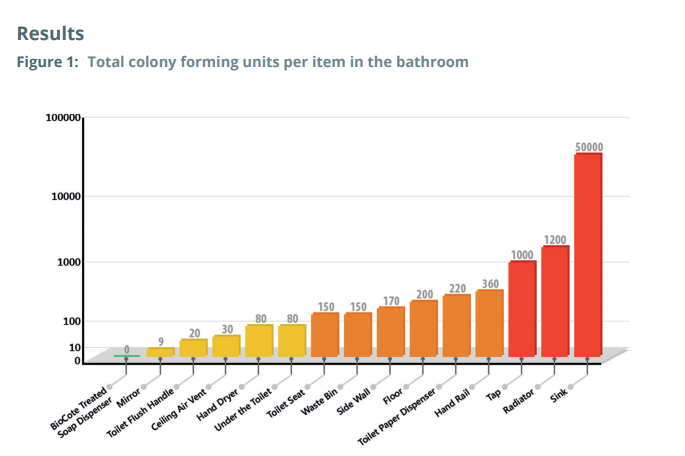How contaminated is a public bathroom?
Public toilets are often judged to be unhygienic places, but does this perception match reality? We examine a public bathroom to find out. Metlam Australia has partnered with international leader, BIOCOTE to find out more. Public bathrooms are often thought of as unhygienic places: high numbers of visitors – with varying awareness of the importance of personal hygiene, ineffectual or an absence of thorough cleaning and the purpose for which they are designed means that public toilets provide the perfect environment for microbes to thrive. Does this idea match reality? Are public toilets really as unhygienic as we think?
Aim
The study looked to understand which items in a public bathroom were the most contaminated with bacteria, and to answer the age-old question: is a public bathroom really the dirtiest item of all?
Method
In order to compare the levels of bacteria on each item of interest in the bathroom, all items were swabbed to find out how much bacteria were living on them. This included the toilet, sink and flooring, as well as the grab rails, toilet paper dispenser, side wall, waste bin, hand dryer, ceiling air vent, mirror and soap
dispenser.
Following the swabbing of the items, the results were then processed in the laboratory and the bacteria recovered from each product was counted.
Results
The dirtiest item in the bathroom was not as you may expect. The most contaminated object in the bathroom was in fact the sink. The object with no bacteria recovered on it was in fact the soap dispenser. This was also the only item to be protected with BioCote antimicrobial technology.

Conclusion
Biocote's findings confirm the common perception that public toilets do harbour potentially high levels of bacteria. Additionally, the only item in the study to not contain any bacteria was the soap dispenser. This finding is particularly interesting considering the dispenser is touched before washing hands. Dr Richard Hastings, microbiologist and BioCote’s Technical Director says: ‘In many cases germs are spread via touch, so we can see that objects touched after people have used the
toilet, but before they have washed their hands can be just as contaminated.’ The less obvious objects and surfaces such as the floor, the wall and the underneath of the toilet were also contaminated. Dr Hastings explains ‘this is probably because people only tend to clean the areas they can see, and the areas where they expect the bugs to grow. Unfortunately, bacteria and mould can be found everywhere and, without thorough cleaning, will keep multiplying. We know most rooms
are full of germs and although they may not necessarily be harmful, the higher the count, the greater the risk of illness.’
Whilst we may perceive items to be cleaner than others, our study highlights that the reality is that we can never really be sure. That’s when BioCote-protected products come into effect. Metlam Australia has partnered with International Leader Biocote to deliver our Antimicrobial Range which reduces the level of bacteria, including MRSA and E.Coli on a protected surface by up to 99.9%.
To find out more about how Metlam Australia Antimicrobial products can assist you in creating a more hygienic washroom environment download here.